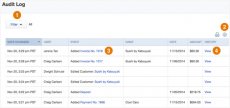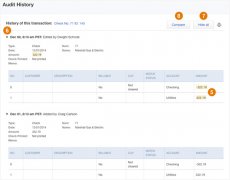QuickBooks Premier 2014 trial Download
 The audit log is a chronological list of your QuickBooks activity — it automatically tracks anything that’s been added, edited, and deleted. It also shows when users sign in and out.
The audit log is a chronological list of your QuickBooks activity — it automatically tracks anything that’s been added, edited, and deleted. It also shows when users sign in and out.
When things go awry and you want to know why, keep calm and view the audit log!
View the audit log
- Click Gear > Audit Log.
- Click Filter to limit the log by user, date range, or event type (transactions, lists, sign in/sign out, recurring templates, and more).
- Click the gear above the table to show/hide columns1.
- Click a link in the Event column to go directly to the event’s form.
- Click View in the History column to see the audit history of an event2.
Our example
- On December 1, Craig enters a check to Marshall Gas & Electric for 2.19.
- On December 2, Dwight changes the amount of that check to 2.19.
 See more details in the audit history
See more details in the audit history
Click View from the previous section to display events one on top of another:
- Changes are highlighted in yellow (in this example, $322.19).
- Click ▼ or ▶ to expand or hide a section.
- Click Show all or Hide all to expand or hide all sections.
- Click Compare to show events side-by-side.
Compare side-by-side to show changes
Click Compare from the previous section to display events side-by-side:
- You can click Show changes only to focus only on changes.
Notes
- You can also access the audit history from a transaction form. For example, at the bottom of the invoice form, click More and choose Audit History.
- Other examples of when you might use the audit log: find deleted transactions that are throwing off the opening balance of a reconciliation, look up the original name of a product/service that you merged into another, check the last time your bookkeeper signed in.






